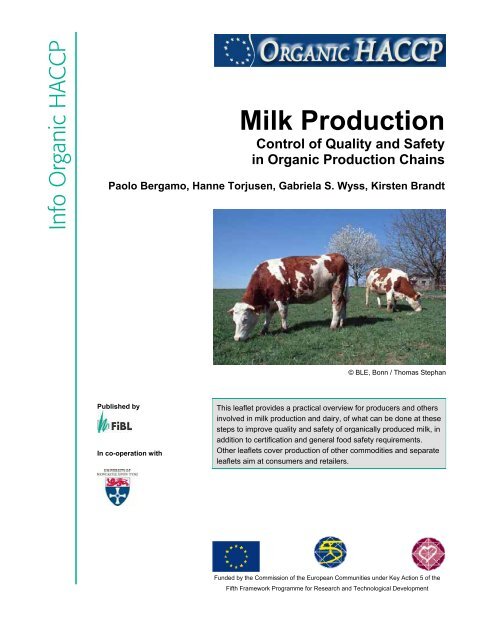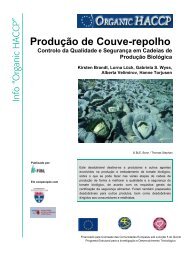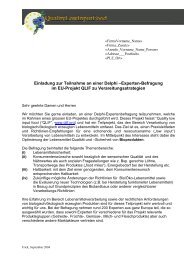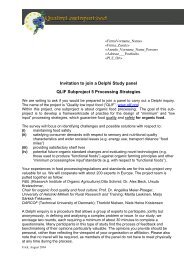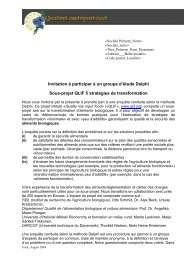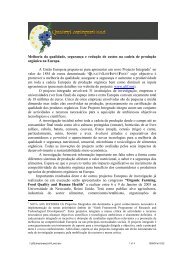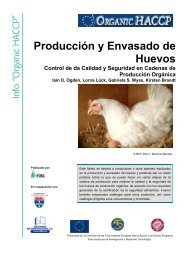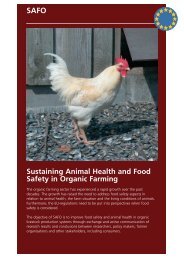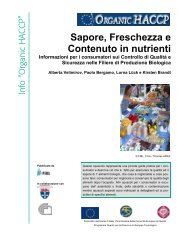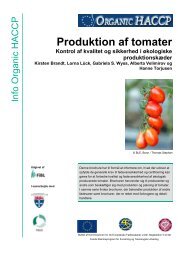Milk Production Control of Quality and Safety in
Milk Production Control of Quality and Safety in
Milk Production Control of Quality and Safety in
You also want an ePaper? Increase the reach of your titles
YUMPU automatically turns print PDFs into web optimized ePapers that Google loves.
Info Organic HACCP<br />
<strong>Milk</strong> <strong>Production</strong><br />
<strong>Control</strong> <strong>of</strong> <strong>Quality</strong> <strong>and</strong> <strong>Safety</strong><br />
<strong>in</strong> Organic <strong>Production</strong> Cha<strong>in</strong>s<br />
Paolo Bergamo, Hanne Torjusen, Gabriela S. Wyss, Kirsten Br<strong>and</strong>t<br />
© BLE, Bonn / Thomas Stephan<br />
Published by<br />
In co-operation with<br />
This leaflet provides a practical overview for producers <strong>and</strong> others<br />
<strong>in</strong>volved <strong>in</strong> milk production <strong>and</strong> dairy, <strong>of</strong> what can be done at these<br />
steps to improve quality <strong>and</strong> safety <strong>of</strong> organically produced milk, <strong>in</strong><br />
addition to certification <strong>and</strong> general food safety requirements.<br />
Other leaflets cover production <strong>of</strong> other commodities <strong>and</strong> separate<br />
leaflets aim at consumers <strong>and</strong> retailers.<br />
Funded by the Commission <strong>of</strong> the European Communities under Key Action 5 <strong>of</strong> the<br />
Fifth Framework Programme for Research <strong>and</strong> Technological Development
The Organic HACCP Project leaflets<br />
This is no. 7 <strong>of</strong> a series <strong>of</strong> 14 leaflets compris<strong>in</strong>g <strong>in</strong>formation<br />
on how control <strong>of</strong> quality <strong>and</strong> safety can be further improved<br />
<strong>in</strong> organic supply cha<strong>in</strong>s across Europe. The Organic<br />
HACCP project has reviewed studies <strong>of</strong> consumer concerns<br />
<strong>and</strong> preferences <strong>in</strong> relation to organic production systems<br />
<strong>and</strong> collected <strong>in</strong>formation about typical production cha<strong>in</strong>s for<br />
7 commodities <strong>in</strong> regions across Europe. For each <strong>of</strong> the<br />
criteria listed below, the <strong>in</strong>formation was analysed to identify<br />
Critical <strong>Control</strong> Po<strong>in</strong>ts (CCPs), def<strong>in</strong>ed as the steps <strong>in</strong> supply<br />
cha<strong>in</strong>s where the qualities <strong>of</strong> the f<strong>in</strong>al product can be<br />
controlled most efficiently. CCPs were identified us<strong>in</strong>g<br />
methods developed for Hazard Analysis by Critical <strong>Control</strong><br />
Po<strong>in</strong>ts (HACCP), a st<strong>and</strong>ard procedure to prevent food<br />
safety risks. The new aspect is thus to improve how consumer<br />
concerns are addressed, through the use <strong>of</strong> the CCP<br />
concept for a wide range <strong>of</strong> criteria, not only safety: 1. Microbial<br />
tox<strong>in</strong>s <strong>and</strong> abiotic contam<strong>in</strong>ants; 2. Potential pathogens;<br />
3. Natural plant toxicants; 4. Freshness <strong>and</strong> taste; 5.<br />
Nutrient content <strong>and</strong> food additives; 6. Fraud; 7. Social <strong>and</strong><br />
ethical aspects.<br />
Overview <strong>of</strong> the cha<strong>in</strong>s exam<strong>in</strong>ed for milk<br />
Cha<strong>in</strong> M1<br />
(Austria)<br />
<strong>Production</strong> <strong>of</strong> milk<br />
by multiple<br />
producers<br />
Transport <strong>of</strong> milk<br />
by transport<br />
company<br />
Process<strong>in</strong>g <strong>of</strong> milk<br />
by dairy<br />
Cha<strong>in</strong> M2<br />
(Denmark)<br />
<strong>Production</strong> <strong>of</strong> milk<br />
by multiple<br />
producers<br />
Transport <strong>of</strong> milk<br />
by dairy<br />
Process<strong>in</strong>g <strong>of</strong> milk<br />
by dairy<br />
The diagram shows the analysed organic supply cha<strong>in</strong>s for<br />
milk throughout Europe. On the project’s homepage<br />
(www.organichaccp.org) they are shown <strong>in</strong> more detail <strong>and</strong><br />
each <strong>of</strong> the CCPs are shown <strong>and</strong> described.<br />
Feed quality <strong>and</strong> composition<br />
Cha<strong>in</strong> M5<br />
(Denmark)<br />
<strong>Production</strong> <strong>of</strong> milk<br />
by multiple<br />
producers<br />
Transport <strong>of</strong> milk<br />
by dairy<br />
Process<strong>in</strong>g <strong>of</strong> milk<br />
by dairy<br />
Pack<strong>in</strong>g <strong>of</strong> milk by<br />
dairy Pack<strong>in</strong>g by dairy Pack<strong>in</strong>g by dairy<br />
Transport <strong>of</strong><br />
packed milk by<br />
dairy<br />
Distribution by<br />
supermarket cha<strong>in</strong><br />
Retail by<br />
supermarket outlet<br />
Distribution by<br />
supermarket cha<strong>in</strong><br />
Retail by<br />
supermarket outlet<br />
Distribution by<br />
supermarket cha<strong>in</strong><br />
Retail by<br />
supermarket outlet<br />
Cha<strong>in</strong> M4<br />
(Norway)<br />
<strong>Production</strong> <strong>of</strong> milk<br />
by s<strong>in</strong>gle producer<br />
Process<strong>in</strong>g <strong>of</strong> milk<br />
by producer<br />
Pack<strong>in</strong>g <strong>of</strong> milk by<br />
producer<br />
Delivery to private<br />
households by<br />
producer<br />
Important issues to control at this step<br />
Some fungal diseases, such as Fusarium <strong>and</strong> Penicillium<br />
can produce mycotox<strong>in</strong>s, which can damage animal or human<br />
health, if they occur <strong>in</strong> gra<strong>in</strong>, hay or other feed.<br />
Feedstuffs can conta<strong>in</strong> the toxic <strong>in</strong>dustrial pollutants diox<strong>in</strong>s.<br />
Feed composition, <strong>in</strong> particular content <strong>of</strong> grass <strong>and</strong> herbs<br />
as roughage, affects taste <strong>and</strong> nutrient content <strong>of</strong> the milk.<br />
Rodent <strong>in</strong>festation can be a source <strong>of</strong> pathogens.<br />
Recommendations<br />
Ensure that the feed storage facilities are kept clean, tidy<br />
<strong>and</strong> rodent free, ensure good control <strong>of</strong> humidity <strong>and</strong> temperature,<br />
even dur<strong>in</strong>g adverse weather conditions.<br />
Check feed at harvest <strong>and</strong> each subsequent week for<br />
appearance (smell <strong>and</strong> colour). For dry materials (gra<strong>in</strong>,<br />
hay), measure humidity <strong>and</strong> temperature <strong>and</strong> plot the values<br />
on a chart. Act immediately if the values become to<br />
high, before any sign <strong>of</strong> mould appear. Discard feed that<br />
smells or looks mouldy.<br />
Check with your feed supplier for results <strong>of</strong> analysis on<br />
diox<strong>in</strong>s <strong>and</strong> mycotox<strong>in</strong>s, <strong>and</strong> consider test<strong>in</strong>g for diox<strong>in</strong>s <strong>in</strong><br />
own produced feed if produced near an <strong>in</strong>dustrial site.<br />
Use as much grass as possible, fresh or as silage, preferably<br />
with a high content <strong>of</strong> aromatic herbs.<br />
Management <strong>of</strong> cows<br />
Important issues to control at this step<br />
Diox<strong>in</strong>s can come from contam<strong>in</strong>ated soil <strong>and</strong> grass <strong>in</strong> pastures.<br />
Diox<strong>in</strong>s accumulate <strong>in</strong> the animal’s body over time.<br />
Specific problems for organic production<br />
Some consumers f<strong>in</strong>d it unethical that male calves are killed<br />
at birth or calves fed conventional milk, e.g. from cows subjected<br />
to extended withhold<strong>in</strong>g periods after medication.<br />
The substantial <strong>in</strong>come loss after antibiotic treatment makes<br />
the decision to <strong>in</strong>tervene difficult <strong>in</strong> case <strong>of</strong> early, ambiguous<br />
symptoms, this can be a risk to animal welfare.<br />
Recommendations<br />
Consider if a pasture is on or near former <strong>in</strong>dustrial sites<br />
or <strong>in</strong>c<strong>in</strong>erators <strong>and</strong> if so, test for diox<strong>in</strong> <strong>and</strong> other persistent<br />
chemicals <strong>in</strong> the soil, or <strong>in</strong> milk fat from old cows.<br />
Support efforts to provide <strong>in</strong>formation to consumers, e.g.<br />
a website or a farm visit scheme, where the agronomic<br />
<strong>and</strong> economic factors are expla<strong>in</strong>ed (e.g. the low quality<br />
<strong>and</strong> price <strong>of</strong> beef from milk<strong>in</strong>g breeds) rather than hidden.<br />
Use a def<strong>in</strong>ed strategy <strong>of</strong> best practice for disease prevention,<br />
adapted to the climatic conditions <strong>and</strong> breed.<br />
Give higher priority to udder health, longevity <strong>and</strong> lifetime<br />
production than to annual yield, when devis<strong>in</strong>g production<br />
plans <strong>and</strong> select<strong>in</strong>g mothers for replacement stock.<br />
<strong>Milk</strong> collection, transport <strong>and</strong> process<strong>in</strong>g at dairy<br />
Important issues to control at this step<br />
Consumers f<strong>in</strong>d it important to know the freshness <strong>of</strong> the<br />
milk they buy.<br />
2
Specific problems for organic production<br />
Often a good organically certified dairy is not available <strong>in</strong> the<br />
local area. Some larger dairies are parallel operations, certified<br />
to h<strong>and</strong>le both organic <strong>and</strong> conventional products. This<br />
gives more options for the farmers, but <strong>in</strong>troduces a risk <strong>of</strong><br />
mix<strong>in</strong>g with conventional milk or accidental use <strong>of</strong> nonallowed<br />
agents or methods.<br />
Recommendations<br />
Collect milk daily, or keep the newest milk separate from<br />
that from the previous day, at the farm <strong>and</strong> <strong>in</strong> the truck.<br />
Use only the freshest milk for fresh consumption, older<br />
milk for yoghurt, cheese etc.<br />
If technically possible, keep milk from different farmers<br />
separate.<br />
In parallel operations, as far as possible use dedicated<br />
trucks <strong>and</strong> other equipment for organic material, <strong>and</strong> mark<br />
them clearly, e.g. by pa<strong>in</strong>t<strong>in</strong>g <strong>in</strong> different colours.<br />
Packag<strong>in</strong>g <strong>and</strong> transport to retail<br />
Important issues to control at this step<br />
For the consumer, the packag<strong>in</strong>g is <strong>of</strong>ten the primary source<br />
<strong>of</strong> <strong>in</strong>formation about the entire production cha<strong>in</strong>. Indications<br />
<strong>of</strong> will<strong>in</strong>gness to take responsibility for the product are important<br />
determ<strong>in</strong>ants for trust. A well-known br<strong>and</strong> is trusted<br />
more than a completely anonymous product, while disclosure<br />
<strong>of</strong> the identity <strong>of</strong> the producer is <strong>of</strong>ten seen as even<br />
stronger pro<strong>of</strong> <strong>of</strong> commitment.<br />
Specific problems for organic production<br />
Homogenisation is to pass milk through a filter at high pressure<br />
to break its fat globules <strong>in</strong>to small pieces, which rema<strong>in</strong><br />
suspended <strong>in</strong> the milk rather than collect<strong>in</strong>g as cream on the<br />
surface. It changes the appearance <strong>and</strong> taste <strong>of</strong> milk, although<br />
op<strong>in</strong>ions differ on if it is an improvement. The EU<br />
food labell<strong>in</strong>g rules do not specify <strong>in</strong>formation about homogenisation,<br />
so <strong>in</strong> some countries this is not compulsory.<br />
Consumers <strong>of</strong> organic products are particularly concerned<br />
with issues such as transparency <strong>and</strong> honesty <strong>in</strong> food production,<br />
<strong>and</strong> they <strong>of</strong>ten support local production.<br />
Recommendations<br />
Include date <strong>of</strong> milk<strong>in</strong>g or specify that the milk was processed<br />
<strong>and</strong> packaged on the day <strong>of</strong> milk<strong>in</strong>g, or that it took<br />
no more than x days from milk<strong>in</strong>g to packag<strong>in</strong>g.<br />
Identify the producer on each package by name (<strong>of</strong> enterprise<br />
or person), not only by an anonymous number. Include<br />
an address or phone number (def<strong>in</strong><strong>in</strong>g area <strong>of</strong> orig<strong>in</strong>,<br />
<strong>and</strong> perhaps a picture or a webpage with additional<br />
<strong>in</strong>formation). If milk from several farms is mixed, then the<br />
dairy should be the transparently identified unit.<br />
Pictures <strong>and</strong> other descriptions on the package or other<br />
promotion material (e.g. advertisements) should illustrate<br />
how the actual production facilities look, not a fairy tale<br />
l<strong>and</strong>scape. A webpage can <strong>in</strong>clude illustrations from both<br />
the dairy <strong>and</strong> examples <strong>of</strong> typical farms.<br />
Def<strong>in</strong>e clearly which processes have been applied to the<br />
milk, <strong>in</strong>clud<strong>in</strong>g homogenisation, centrifugation, reconstitution,<br />
pasteurisation etc., even if this <strong>in</strong>formation is not<br />
formally required. Expla<strong>in</strong> complex terms.<br />
General Recommendations<br />
Exchange <strong>in</strong>formation about your quality control <strong>and</strong> their<br />
quality measurements with the companies <strong>and</strong> persons <strong>in</strong><br />
charge <strong>of</strong> the other parts <strong>of</strong> the cha<strong>in</strong>. Formal or <strong>in</strong>formal<br />
collaboration agreements can ensure that quality <strong>and</strong> safety<br />
is controlled at every step <strong>of</strong> the supply cha<strong>in</strong>, <strong>and</strong> that the<br />
costs <strong>of</strong> this are shared fairly among the participants.<br />
Cont<strong>in</strong>uation <strong>in</strong> the QLIF project<br />
The work <strong>of</strong> Organic HACCP identified several areas where more<br />
research is needed to improve the control <strong>of</strong> quality <strong>and</strong> safety <strong>of</strong><br />
organic products. In 2004 the project <strong>Quality</strong>LowInputFood (QLIF,<br />
www.qlif.org) was started to broaden the underst<strong>and</strong><strong>in</strong>g <strong>of</strong> quality <strong>of</strong><br />
organic food. QLIF is an Integrated Project <strong>in</strong> the European Commission’s<br />
6 th Framework Programme with 31 participants <strong>in</strong> 15<br />
countries. QLIF is a 5-year project aim<strong>in</strong>g to provide research <strong>and</strong><br />
development on quality, safety <strong>and</strong> efficiency <strong>of</strong> organic <strong>and</strong> other<br />
low-<strong>in</strong>put farm<strong>in</strong>g methods <strong>in</strong> Europe. The follow<strong>in</strong>g topics relevant<br />
for quality <strong>and</strong> safety <strong>of</strong> milk production will be <strong>in</strong>vestigated <strong>in</strong> QLIF:<br />
Studies <strong>of</strong> relations between different aspects <strong>of</strong> food quality,<br />
consumer perceptions <strong>and</strong> buy<strong>in</strong>g behaviour (Consumer expectations<br />
<strong>and</strong> attitudes, 2004-2007).<br />
Effect <strong>of</strong> dairy management practices on production efficiency,<br />
milk quality <strong>and</strong> herd health status <strong>and</strong> reproductive efficiency<br />
(Effects <strong>of</strong> production methods, 2004-2008).<br />
Development <strong>of</strong> improved preventive management strategies for<br />
mastitis, <strong>and</strong> study <strong>of</strong> effects <strong>of</strong> feed<strong>in</strong>g regimes on enteric<br />
pathogen transfer risk, sensory <strong>and</strong> nutritional quality <strong>of</strong> milk<br />
(Livestock production systems, 2004-2008).<br />
Assessment <strong>of</strong> process<strong>in</strong>g technologies that may improve the<br />
nutritional composition <strong>of</strong> dairy products (Process<strong>in</strong>g strategies,<br />
2004-2008).<br />
Development <strong>of</strong> HACCP procedures for control <strong>of</strong> quality <strong>and</strong><br />
safety <strong>in</strong> organic supply cha<strong>in</strong>s <strong>and</strong> tra<strong>in</strong><strong>in</strong>g courses for advisors<br />
(Transport, trad<strong>in</strong>g <strong>and</strong> retail<strong>in</strong>g, 2006-2008).<br />
3
Editorial Notes<br />
The editors <strong>and</strong> authors gratefully acknowledge f<strong>in</strong>ancial<br />
support from the Commission <strong>of</strong> the European Communities<br />
under Key Action 5 <strong>of</strong> the Fifth Framework Research <strong>and</strong><br />
Technological Development Programme <strong>and</strong> co-fund<strong>in</strong>g by<br />
the Swiss Science Agency (SBF) for the project "Recommendations<br />
for improved procedures for secur<strong>in</strong>g consumer<br />
oriented food safety <strong>and</strong> quality <strong>of</strong> certified organic products<br />
from plough to plate" (Organic HACCP; QLK1-CT-2002-<br />
02245). The views expressed are those <strong>of</strong> the authors <strong>and</strong><br />
do not necessarily reflect the views <strong>of</strong> the European Commission,<br />
nor do they <strong>in</strong> any way anticipate the Commission's<br />
future policy <strong>in</strong> this area.<br />
The contents <strong>of</strong> this leaflet are the sole responsibility <strong>of</strong> the<br />
authors. The <strong>in</strong>formation conta<strong>in</strong>ed here<strong>in</strong>, <strong>in</strong>clud<strong>in</strong>g any<br />
expression <strong>of</strong> op<strong>in</strong>ion <strong>and</strong> any projection or forecast, has<br />
been obta<strong>in</strong>ed from sources believed by the authors to be<br />
reliable but is not guaranteed as to accuracy or completeness.<br />
The <strong>in</strong>formation is supplied without obligation <strong>and</strong> on<br />
the underst<strong>and</strong><strong>in</strong>g that any person who acts upon it or otherwise<br />
changes his/her position <strong>in</strong> reliance thereon does so<br />
entirely at his/her own risk.<br />
Bibliographical Information<br />
Paolo Bergamo, Hanne Torjusen, Gabriela S. Wyss, Kirsten<br />
Br<strong>and</strong>t (2005): <strong>Milk</strong> <strong>Production</strong>, <strong>Control</strong> <strong>of</strong> <strong>Quality</strong> <strong>and</strong><br />
<strong>Safety</strong> <strong>in</strong> Organic <strong>Production</strong> Cha<strong>in</strong>s. Research Institute <strong>of</strong><br />
Organic Agriculture FiBL, CH-5070 Frick, Switzerl<strong>and</strong><br />
© 2004, Research Institute <strong>of</strong> Organic Agriculture FiBL <strong>and</strong><br />
University <strong>of</strong> Newcastle upon Tyne<br />
FiBL, Ackerstrasse, CH-5070 Frick, Tel. +41 62 865 7272,<br />
Fax +41 62 865 7273, e-mail <strong>in</strong>fo.suisse@fibl.org, Internet<br />
http://www.fibl.org<br />
University <strong>of</strong> Newcastle, Agriculture Build<strong>in</strong>g, Newcastle<br />
upon Tyne UK - NE1 7RU, e-mail<br />
organic.haccp@ncl.ac.uk, Internet<br />
http://www.ncl.ac.uk/afrd/tcoa/<br />
Language edit<strong>in</strong>g: Kirsten Br<strong>and</strong>t<br />
Cover & layout: FiBL<br />
Logo Organic HACCP: T<strong>in</strong>a Hansen, DIAS, Denmark<br />
A PDF version can be downloaded free <strong>of</strong> charge from the<br />
project <strong>in</strong>ternet site at www.organichaccp.org or from<br />
www.orgpr<strong>in</strong>ts.org/view/projects/eu-organic-haccp.html.<br />
Pr<strong>in</strong>ted versions can be ordered from the FiBL Shop at<br />
www.shop.fibl.org.<br />
Authors<br />
Paolo Bergamo (ISA), Hanne Torjusen (SIFO), Gabriela S.<br />
Wyss (FiBL) <strong>and</strong> Kirsten Br<strong>and</strong>t (UNEW).<br />
Contact:<br />
Paolo Bergamo, ISA: Institute <strong>of</strong> Food Science <strong>and</strong> Technology,<br />
Via Roma 52, 83100 Avell<strong>in</strong>o, Italy.<br />
Tel. +39 0825 299506<br />
Fax: +39 0825 299105<br />
e-mail: p.bergamo@isa.av.cnr.it<br />
Internet: http://www.isa.cnr.it<br />
About Organic HACCP<br />
The ma<strong>in</strong> objectives <strong>of</strong> this Concerted Action are to assess<br />
current procedures for production management <strong>and</strong> control<br />
<strong>in</strong> organic production cha<strong>in</strong>s, with particular reference to the<br />
characteristics valued by consumers, <strong>and</strong> from this to formulate<br />
<strong>and</strong> dissem<strong>in</strong>ate recommendations for improvements.<br />
The 2-year project started <strong>in</strong> February 2003. The results <strong>of</strong><br />
the project, <strong>in</strong>clud<strong>in</strong>g a database <strong>of</strong> Critical <strong>Control</strong> Po<strong>in</strong>ts <strong>in</strong><br />
the analysed cha<strong>in</strong>s, are available on the project website<br />
www.organichaccp.org.<br />
The Project Partners<br />
University <strong>of</strong> Newcastle (UNEW), Newcastle upon Tyne,<br />
United K<strong>in</strong>gdom.<br />
Swiss Research Institute <strong>of</strong> Organic Agriculture (FiBL),<br />
Frick, Switzerl<strong>and</strong>.<br />
Royal Veter<strong>in</strong>ary <strong>and</strong> Agricultural University (KVL), Copenhagen,<br />
Denmark.<br />
Italian National Research Council, Institute <strong>of</strong> Food Science<br />
<strong>and</strong> Technology (CNR-ISA), Avell<strong>in</strong>o, Italy.<br />
University <strong>of</strong> Aberdeen (UNIABDN), Aberdeen, United<br />
K<strong>in</strong>gdom<br />
Ludwig Boltzmann Institute for Biological Agriculture (LBI)<br />
Vienna, Austria.<br />
Universidade de Trás-os-Montes e Alto Douro (UTAD),<br />
Vila Real, Portugal.<br />
Agro EcoConsultancy BV (Agro Eco), Bennekom, The<br />
Netherl<strong>and</strong>s.<br />
National Institute for Consumer Research (SIFO), Oslo,<br />
Norway.<br />
4


